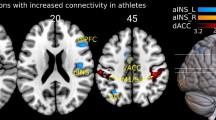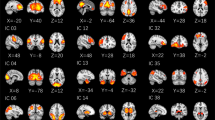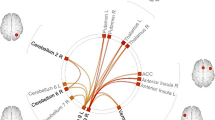Abstract
Baroreflex regulates short-term cardiovascular variability via the autonomic neural system. The contributions of the central autonomic system to the baroreflex regulations of arterial blood pressure (BP) and heart rate have been reported in young healthy adults, but not in older adults. Therefore, we investigated the association between the high-level central autonomic network (CAN) connectivity and baroreflex sensitivity (BRS) under a resting condition in a healthy older population. Twenty-two older adults (68 ± 8 years old) underwent BRS assessment using the modified Oxford and transfer function methods. Resting-state brain functional MRI was performed to assess the CAN functional connectivity at rest. We found that the functional connectivity (FC) between the left amygdala and left medial frontal gyrus (MeFG), bilateral postcentral gyri and bilateral paracentral lobules (PCL) is associated with BRS and R–R interval (RRI) variability in the low-frequency (LF) range. Compared to the left amygdala, the FC map of the right amygdala only showed significant associations with BRS in the anterior cingulate cortex (ACC) and with RRI variability in the left occipital region. In addition, post hoc analysis of the functionally defined left insula sub-region confirmed the association between CAN and BRS. Overall, our study demonstrates that CAN and its related brain regions may be involved, likely in a left-lateral manner, in peripheral cardiac autonomic regulation at rest. The results highlight the potential importance of brain neural network function in maintaining cardiovascular homeostasis in older adults.




Similar content being viewed by others
References
Aengevaeren VL, Claassen JA, Levine BD, Zhang R (2013) Cardiac baroreflex function and dynamic cerebral autoregulation in elderly Masters athletes. J Appl Physiol 114:195–202. https://doi.org/10.1152/japplphysiol.00402.2012
Benarroch EE (1993) The central autonomic network: functional organization, dysfunction, and perspective. Mayo Clin Proc 68:988–1001
Benarroch EE (2015) The amygdala: functional organization and involvement in neurologic disorders. Neurology 84:313–324. https://doi.org/10.1212/WNL.0000000000001171
Birn RM (2012) The role of physiological noise in resting-state functional connectivity. Neuroimage 62:864–870. https://doi.org/10.1016/j.neuroimage.2012.01.016
Brant-Zawadzki M, Gillan GD, Nitz WR (1992) MP RAGE: a three-dimensional, T1-weighted, gradient-echo sequence–initial experience in the brain. Radiology 182:769–775. https://doi.org/10.1148/radiology.182.3.1535892
Cechetto DF (2014) Cortical control of the autonomic nervous system. Exp Physiol 99:326–331. https://doi.org/10.1113/expphysiol.2013.075192
Cersosimo MG, Benarroch EE (2013) Central control of autonomic function and involvement in neurodegenerative disorders. Handb Clin Neurol 117:45–57. https://doi.org/10.1016/B978-0-444-53491-0.00005-5
Chang C, Metzger CD, Glover GH, Duyn JH, Heinze HJ, Walter M (2013) Association between heart rate variability and fluctuations in resting-state functional connectivity. Neuroimage 68:93–104. https://doi.org/10.1016/j.neuroimage.2012.11.038
Choudhary N et al (2017) Comparison of Autonomic Function before and after Surgical Intervention in Patients with Temporal Lobe Epilepsy J. Epilepsy Res 7:89–98. https://doi.org/10.14581/jer.17014
Cox RW (1996) AFNI: software for analysis and visualization of functional magnetic resonance neuroimages. Comput Biomed Res 29:162–173
Critchley HD et al (2003) Human cingulate cortex and autonomic control: converging neuroimaging and clinical evidence. Brain 126:2139–2152. https://doi.org/10.1093/brain/awg216
Crum RM, Anthony JC, Bassett SS, Folstein MF (1993) Population-based norms for the Mini-Mental State Examination by age and educational level. JAMA 269:2386–2391
Desikan RS et al (2006) An automated labeling system for subdividing the human cerebral cortex on MRI scans into gyral based regions of interest. Neuroimage 31:968–980. https://doi.org/10.1016/j.neuroimage.2006.01.021
Duschek S, Werner NS, Reyes Del Paso GA (2013) The behavioral impact of baroreflex function: a review. Psychophysiology 50:1183–1193. https://doi.org/10.1111/psyp.12136
Fischl B et al (2002) Whole brain segmentation: automated labeling of neuroanatomical structures in the human brain. Neuron. 33:341–355
Fisher JP, Kim A, Hartwich D, Fadel PJ (2012) New insights into the effects of age and sex on arterial baroreflex function at rest and during dynamic exercise in humans. Auton Neurosci 172:13–22. https://doi.org/10.1016/j.autneu.2012.10.013
Folstein MF, Folstein SE, McHugh PR (1975) Mini-mental state. A practical method for grading the cognitive state of patients for the clinician. J Psychiatr Res 12:189–198. https://doi.org/10.1016/0022-3956(75)90026-6
Fox MD, Snyder AZ, Vincent JL, Corbetta M, Van Essen DC, Raichle ME (2005) The human brain is intrinsically organized into dynamic, anticorrelated functional networks. Proc Natl Acad Sci USA 102:9673–9678. https://doi.org/10.1073/pnas.0504136102
Gianaros PJ, Onyewuenyi IC, Sheu LK, Christie IC, Critchley HD (2012) Brain systems for baroreflex suppression during stress in humans. Hum Brain Mapp 33:1700–1716. https://doi.org/10.1002/hbm.21315
Henderson LA et al (2002) Brain responses associated with the Valsalva maneuver revealed by functional magnetic resonance imaging. J Neurophysiol 88:3477–3486. https://doi.org/10.1152/jn.00107.2002
Iwasaki KI, Zhang R, Zuckerman JH, Pawelczyk JA, Levine BD (2000) Effect of head-down-tilt bed rest and hypovolemia on dynamic regulation of heart rate and blood pressure. Am J Physiol Regul Integr Comp Physiol 279:R2189–2199. https://doi.org/10.1152/ajpregu.2000.279.6.R2189
Katona PG, Jih F (1975) Respiratory sinus arrhythmia: noninvasive measure of parasympathetic cardiac control. J Appl Physiol 39:801–805. https://doi.org/10.1152/jappl.1975.39.5.801
Kimmerly DS (2017) A review of human neuroimaging investigations involved with central autonomic regulation of baroreflex-mediated cardiovascular control. Auton Neurosci. https://doi.org/10.1016/j.autneu.2017.05.008
Kimmerly DS, O’Leary DD, Menon RS, Gati JS, Shoemaker JK (2005) Cortical regions associated with autonomic cardiovascular regulation during lower body negative pressure in humans. J Physiol 569:331–345. https://doi.org/10.1113/jphysiol.2005.091637
Kurth F, Zilles K, Fox PT, Laird AR, Eickhoff SB (2010) A link between the systems: functional differentiation and integration within the human insula revealed by meta-analysis. Brain Struct Funct 214:519–534. https://doi.org/10.1007/s00429-010-0255-z
Lipman RD, Salisbury JK, Taylor JA (2003) Spontaneous indices are inconsistent with arterial baroreflex gain. Hypertension 42:481–487. https://doi.org/10.1161/01.HYP.0000091370.83602.E6
Macey PM, Wu P, Kumar R, Ogren JA, Richardson HL, Woo MA, Harper RM (2012) Differential responses of the insular cortex gyri to autonomic challenges. Auton Neurosci 168:72–81. https://doi.org/10.1016/j.autneu.2012.01.009
Macey PM, Ogren JA, Kumar R, Harper RM (2015) Functional imaging of autonomic regulation: methods and key findings. Front Neurosci 9:513. https://doi.org/10.3389/fnins.2015.00513
Mancia G, Groppelli A, Di Rienzo M, Castiglioni P, Parati G (1997) Smoking impairs baroreflex sensitivity in humans. Am J Physiol 273:H1555–1560. https://doi.org/10.1152/ajpheart.1997.273.3.H1555
Monahan KD (2007) Effect of aging on baroreflex function in humans. Am J Physiol Regul Integr Comp Physiol 293:R3–R12. https://doi.org/10.1152/ajpregu.00031.2007
Murphy K, Birn RM, Bandettini PA (2013) Resting-state fMRI confounds and cleanup. Neuroimage 80:349–359. https://doi.org/10.1016/j.neuroimage.2013.04.001
Nieuwenhuys R (2012) The insular cortex: a review. Prog Brain Res 195:123–163. https://doi.org/10.1016/B978-0-444-53860-4.00007-6
Ogren JA, Macey PM, Kumar R, Woo MA, Harper RM (2010) Central autonomic regulation in congenital central hypoventilation syndrome. Neuroscience 167:1249–1256. https://doi.org/10.1016/j.neuroscience.2010.02.078
Oppenheimer SM, Gelb A, Girvin JP, Hachinski VC (1992) Cardiovascular effects of human insular cortex stimulation. Neurology 42:1727–1732
Pinna GD, Maestri R, Capomolla S, Febo O, Robbi E, Cobelli F, La Rovere MT (2005) Applicability and clinical relevance of the transfer function method in the assessment of baroreflex sensitivity in heart failure patients. J Am Coll Cardiol 46:1314–1321. https://doi.org/10.1016/j.jacc.2005.06.062
Ritz T, Dahme B (2006) Implementation and interpretation of respiratory sinus arrhythmia measures in psychosomatic medicine: practice against better evidence? Psychosom Med 68:617–627. https://doi.org/10.1097/01.psy.0000228010.96408.ed
Saha S, Drinkhill MJ, Moore JP, Batten TF (2005) Central nucleus of amygdala projections to rostral ventrolateral medulla neurones activated by decreased blood pressure. Eur J Neurosci 21:1921–1930. https://doi.org/10.1111/j.1460-9568.2005.04023.x
Seeley WW et al (2007) Dissociable intrinsic connectivity networks for salience processing and executive control. J Neurosci 27:2349–2356. https://doi.org/10.1523/JNEUROSCI.5587-06.2007
Steptoe A, Sawada Y (1989) Assessment of baroreceptor reflex function during mental stress and relaxation. Psychophysiology 26:140–147. https://doi.org/10.1111/j.1469-8986.1989.tb03145.x
Tarumi T et al (2015) Central artery stiffness, baroreflex sensitivity, and brain white matter neuronal fiber integrity in older adults. Neuroimage 110:162–170. https://doi.org/10.1016/j.neuroimage.2015.01.041
Wilhelm FH, Grossman P, Coyle MA (2004) Improving estimation of cardiac vagal tone during spontaneous breathing using a paced breathing calibration. Biomed Sci Instrum 40:317–324
Woo MA, Macey PM, Keens PT, Kumar R, Fonarow GC, Hamilton MA, Harper RM (2005) Functional abnormalities in brain areas that mediate autonomic nervous system control in advanced heart failure. J Card Fail 11:437–446. https://doi.org/10.1016/j.cardfail.2005.02.003
Xing CY et al (2017) Arterial Pressure, Heart Rate, and Cerebral Hemodynamics Across the Adult Life Span. Hypertension 69:712–720. https://doi.org/10.1161/HYPERTENSIONAHA.116.08986
Zhang R, Zuckerman JH, Giller CA, Levine BD (1998) Transfer function analysis of dynamic cerebral autoregulation in humans. Am J Physiol 274:H233–241
Zhang R, Iwasaki K, Zuckerman JH, Behbehani K, Crandall CG, Levine BD (2002a) Mechanism of blood pressure and R-R variability: insights from ganglion blockade in humans. J Physiol 543:337–348
Zhang R, Zuckerman JH, Iwasaki K, Wilson TE, Crandall CG, Levine BD (2002b) Autonomic neural control of dynamic cerebral autoregulation in humans. Circulation 106:1814–1820
Zhu DC, Majumdar S, Korolev IO, Berger KL, Bozoki AC (2013) Alzheimer’s disease and amnestic mild cognitive impairment weaken connections within the default-mode network: a multi-modal imaging study. J Alzheimers Dis 34:969–984. https://doi.org/10.3233/JAD-121879
Zhu DC, Tarumi T, Khan MA, Zhang R (2015) Vascular coupling in resting-state fMRI: evidence from multiple modalities. J Cereb Blood Flow Metab 35:1910–1920. https://doi.org/10.1038/jcbfm.2015.166
Acknowledgements
The authors thank the study participants for their time and effort, and Drs. Samarpita Sengupta and Jon Reid for their editing assistance.
Funding
This study was funded by the National Institute of Health (R01AG033106, R01HL102457, and K99HL133449) and the Darrell Royal Research Foundation.
Author information
Authors and Affiliations
Contributions
KD: study concept and design, data analysis, and interpretation, drafting and revising the manuscript. TT: study concept and design, data analysis, interpretation, and revising the manuscript. CW: data analysis. SV: study concept and design, data interpretation, and revising the manuscript. RZ: study concept and design, data interpretation, and revising the manuscript. DZ: study concept and design, data analysis, data interpretation, and revising the manuscript.
Corresponding author
Ethics declarations
Conflict of interest
The authors declare that they have no conflict of interest.
Additional information
Publisher's Note
Springer Nature remains neutral with regard to jurisdictional claims in published maps and institutional affiliations.
Rights and permissions
About this article
Cite this article
Ding, K., Tarumi, T., Wang, C. et al. Central autonomic network functional connectivity: correlation with baroreflex function and cardiovascular variability in older adults. Brain Struct Funct 225, 1575–1585 (2020). https://doi.org/10.1007/s00429-020-02075-w
Received:
Accepted:
Published:
Issue Date:
DOI: https://doi.org/10.1007/s00429-020-02075-w




